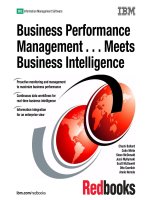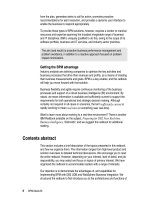The family business group phenomenon emergence and complexities
Bạn đang xem bản rút gọn của tài liệu. Xem và tải ngay bản đầy đủ của tài liệu tại đây (5.61 MB, 294 trang )
Editors
MaritaRautiainen,PeterRosa,TimoPihkala,MariaJoséParadaandAllanDiscuaCruz
TheFamilyBusinessGroupPhenomenon
EmergenceandComplexities
Editors
MaritaRautiainen
SchoolofEngineeringScienceLappeenrantaUniversityofTechnology,Lahti,Finland
PeterRosa
BusinessSchool,UniversityofEdinburgh,Edinburgh,UK
TimoPihkala
SchoolofEngineeringScienceLappeenrantaUniversityofTechnology,Lahti,Finland
MariaJoséParada
StrategyandGeneralManagementDepartment,ESADEBusinessSchool,Barcelona,Spain
AllanDiscuaCruz
DepartmentofEntrepreneurshipandStrategy,LancasterUniversityManagementSchool,
Lancaster,UK
ISBN978-3-319-98541-1 e-ISBN978-3-319-98542-8
/>LibraryofCongressControlNumber:2018957330
©TheEditor(s)(ifapplicable)andTheAuthor(s)2019
Thisworkissubjecttocopyright.Allrightsaresolelyandexclusivelylicensedbythe
Publisher,whetherthewholeorpartofthematerialisconcerned,specificallytherightsof
translation,reprinting,reuseofillustrations,recitation,broadcasting,reproductionon
microfilmsorinanyotherphysicalway,andtransmissionorinformationstorageand
retrieval,electronicadaptation,computersoftware,orbysimilarordissimilarmethodology
nowknownorhereafterdeveloped.
Theuseofgeneraldescriptivenames,registerednames,trademarks,servicemarks,etc.in
thispublicationdoesnotimply,evenintheabsenceofaspecificstatement,thatsuchnames
areexemptfromtherelevantprotectivelawsandregulationsandthereforefreeforgeneral
use.
Thepublisher,theauthorsandtheeditorsaresafetoassumethattheadviceandinformation
inthisbookarebelievedtobetrueandaccurateatthedateofpublication.Neitherthe
publishernortheauthorsortheeditorsgiveawarranty,expressorimplied,withrespectto
thematerialcontainedhereinorforanyerrorsoromissionsthatmayhavebeenmade.The
publisherremainsneutralwithregardtojurisdictionalclaimsinpublishedmapsand
institutionalaffiliations.
ThisPalgraveMacmillanimprintispublishedbytheregisteredcompanySpringerNature
SwitzerlandAG
Theregisteredcompanyaddressis:Gewerbestrasse11,6330Cham,Switzerland
Acknowledgements
Thisbookwouldnothavebeenpossiblewithoutthefamilieswhoinvitedusintotheir
businesslives.Wehaveseenfamilybusinessesofallsizesfromallovertheworld.Weare
gratefultoallofthosefamilymemberswithwhomwehavehadthepleasuretoworkduring
thisandotherrelatedprojectsthathelpedustocompilethisbook.
Writingabookrequirestheworkoflargenumbersofpeople.Itisimportanttousas
editorsinthisdevelopingprofessionalfieldtoacknowledgetheinfluenceandcontributions
ofourcolleagues.Wewanttothankalltheauthorswhogavetheirvaluabledata,timeand
effortinwritingandfinishingdifferentchaptersofthisbook.
Duringtheyearsofresearch,therehasbeenfinancialsupportofseveralkinds.InFinland,
FoundationforEntrepreneurshipResearchandFoundationforEconomicEducationhave
supportedtheresearchofthistopicinseveralprojects,ashasGeorgeDavid’sEndowmentin
fundingactivitiesoftheEdinburghUniversityBusinessSchoolresearchinthisbook.Special
thankstotheDepartmentofEntrepreneurshipandStrategyatLancasterUniversity
ManagementSchoolforcontinuedsupport.WeareparticularlygratefultotheDepartmentof
StrategyandGeneralManagementatESADEandtheSTEPprojectinSpain.
ThePalgraveMacmillanpresshasoursincerethanksforhelpingusturnourresearchinto
apublication.
Contents
1Introduction:PresentingtheCaseforStudyingtheEmergenceandDevelopmentof
FamilyBusinessGroups
PeterRosa,MaritaRautiainen,TimoPihkala,MariaJoséParadaandAllanDiscuaCruz
1.1TheVisionandOrganizationoftheBook
References
PartI TheoreticalandMethodologicalReflections
2TheoreticalInsightsintotheNature,DiversityandPersistenceofBusinessGroups
PeterRosaandTimoPihkala
2.1Introduction
2.2TheEmergenceofBusinessGroupsandtheRoleofPortfolioEntrepreneurship
2.3Conclusion
References
3TheMethodologicalChallengesofResearchingFamily-OwnedBusinessGroups
PeterRosa,MaritaRautiainenandTimoPihkala
3.1Introduction
3.2MethodologicalChallenge1:IdentifyingandRefiningKeyResearchQuestions
andTheories
3.3MethodologicalChallenge2:DefinitionalChallenges
3.3.1UnpackingtheDefinitionalComplexitiesofBusinessGroupsandFamily
BusinessGroups
3.3.2UnpackingtheComplexitiesofLegalEntitiesandAffiliates
3.3.3DefiningPortfolioEntrepreneurship
3.4MethodologicalChallenge3:FamilyBusinessDatabasesAmenabletoRigorous
StatisticalAnalysisAreDifficulttoFindandAccess
3.5MethodologicalChallenge4:ThePhenomenonIsaDifficultProcesstoResearch
RigorouslyOverTime
3.6MethodologicalChallenge5:ResearchersofFamilyBusinessGroupsand
PortfoliosEncountertheChallengesofMapping,RecordingandAnalysing
Complexity
3.6.1Identifying,DescribingandMappingComplexFamilyBusinessGroups
3.7Conclusion
References
PartII TheEmergenceofFamilyBusinessGroupsThroughPortfolioEntrepreneurship
4TheEmergenceofaFamilyBusinessGroup:TheRoleofPortfolioEntrepreneurship
MaritaRautiainenandTimoPihkala
4.1Introduction
4.2BusinessGroupEmergenceThroughPortfolioEntrepreneurship:ACaseStudy
4.2.1ThePortfolioEntrepreneur
4.2.2TheEntrepreneurialModelforDiversification
4.2.3TheEmergenceofaFamilyBusiness
4.2.4BalancingEntrepreneurshipandRetainingWealth
4.3DiscussionoftheCaseStudy
4.3.1BuildingthePortfolio
4.3.2TheCharacteristicsofFamilyBusinessEntrepreneurshipandBusiness
Group
4.3.3TheComplexGroupStructure,OrganizedAccordingtotheFamilyMembers
4.4Conclusion
References
5ManagingPortfolioEntrepreneurship:ACaseStudy
DonatoIacobucciandPeterRosa
5.1Introduction
5.2ResearchMethod
5.3ThePiginiGroup:HistoryOutline
5.4NewVentureCreationandEntrepreneurialTeamFormation
5.5TheDynamicsofEntrepreneurialTeamsinKnowledge-IntensiveBusinesses
5.6Conclusions
References
6EntrepreneurialGrowthThroughPortfolioEntrepreneurship:TheEntrepreneurial
CareerLadder
PeterRosa
6.1Introduction
6.2LearningfromIndigenousEntrepreneurship
6.3EastAfricanIndigenousEntrepreneurshipSystems
6.4ConceptualisingtheEntrepreneurialCareerLadder(ECL)
6.5CaseStudiestoIllustratethe“LadderProcess”atWork
6.5.1CaseStudyOne:MosestheSkinner
6.5.2CaseStudyTwo:JeremiahButchery:FredNgombo(NameChanged)
6.5.3CaseStudyThree:SudhirRuparelia:StartingAgainThroughCashFlowand
Property
6.5.4CaseFour:TheECLandaTrans-generationalUgandanFamily—The
Madhvanis
6.6BusinessFailure
6.7CaseExamplesofaMismatchofEntrepreneurialandBusinessLevels
6.7.1Analysis
6.8ExampleofSquanderingInheritancebyStartingattheWrongLevel
6.8.1Analysis
6.9Conclusion
References
7ResourcefulnessandInformalEconomy:FromPluriactivitytoPortfolio
Entrepreneurship
NaveedAkhterandErnestineNing
7.1Introduction
7.2TheoreticalBackground
7.2.1PluriactivityandPortfolioEntrepreneurship
7.2.2InformalEconomiesandEntrepreneurialResourcefulness
7.3PropositionDevelopment
7.4Discussion
7.4.1FurtherResearch
7.4.2ConcludingRemarks
References
PartIII ComplexityandtheDevelopmentofFamilyBusinessGroups
8TheDynamicsandComplexityofFamilyBusinessGroups
KajariMukherjee,MaritaRautiainen,TimoPihkalaandPeterRosa
8.1Introduction
8.2FamilyBusinessGroupComplexity
8.3ResearchMethodology
8.4TheEmpiricalSetting
8.5ConceptualizingtheCaseFamilyBusinessGroupasaComplexAdaptiveSystem
8.6AcceptingtheComplexityoftheFamilyBusinessGroup
8.7Conclusion
References
9UnderstandingtheDynamicsofBusinessGroupDevelopment:ATransgenerational
Perspective
MariaJoséParada,NaveedAkhter,RodrigoBasco,AllanDiscuaCruzandSarahFitz-Koch
9.1Introduction
9.2LiteratureReview
9.2.1FamilyFirms
9.2.2TransgenerationalEntrepreneurshipandFamilyBusinessGroups
9.3MethodandCaseAnalysis
9.4Discussion
9.4.1AbilitytoTransformtheBusinessModel
9.4.2OwnershipConcentration
9.4.3Familiness
9.4.4EntrepreneurialOrientation
9.4.5ValueTransformation
9.5Conclusion
References
10DecipheringOwnershipofFamilyBusinessGroups
TimoPihkala,SanjayGoel,MaritaRautiainen,KajariMukherjeeandMarkkuIkävalko
10.1Introduction
10.2AbouttheConceptofOwnership
10.3FamilyBusinessGroupasaSetofLegalOwnership
10.3.1TheBenefitsofControllingtheBusinessandItsResourcesinFamily
BusinessGroups
10.3.2TheBenefitsofIncludingOutsideInvestorsintheDistinctBusinessesin
theGroup
10.3.3TheBenefitofOperatingontheLevelsofCollectiveOwnershipand
IndividualOwnership
10.4EmotionalandSocialBenefitsofOwningaFamilyBusinessGroup
10.4.1TheBenefitsofOwningFamilyBusinessGrouponPersonalGoals
10.4.2TheBenefitsofFamilyBusinessGroupOwnershiponFamilyCohesionand
BusinessContinuity
10.4.3SocialBenefitsofOwningaFamilyBusinessGroup
10.5ManagingtheComplexityoftheOwnershipofFamilyBusinessGroups
10.6FutureDirectionsforResearch
10.7Conclusions
References
11GovernanceinFamilyBusinessGroups:ResolvingMultipleContingenciestoSustain
EntrepreneurialCapability
SanjayGoel,TuuliIkäheimonenandMaritaRautiainen
11.1Introduction
11.2TheMeaningoftheContextandGoalsforGovernance
11.2.1FamilyBusinessGovernance
11.2.2FBGsEmergeforaVarietyofReasons
11.2.3GoalsCreatetheBasisforGovernance
11.2.4AGovernanceSystemConsistsofStructures,MechanismsandProcesses
11.3FBGGovernance
11.4DiscussionandFutureResearch
11.5Conclusions
References
PartIV FamilyBusinessGroupsinDifferentLocalContexts
12TheContributionofFamilyBusinessGroupstotheLocalInnovationEnvironment
SuviKonsti-Laakso,JussiHeikkilä,MaritaRautiainen,SatuRinkinenandNaveedAkhter
12.1Introduction
12.2FamilyBusinessGroupsandInnovation
12.3FamilyBusinessesinaRegionalInnovationSystem
12.4MethodologyandData
12.5CaseLahti:DescriptionandEmpiricalFindings
12.5.1TheCharacteristicsoftheLahtiRegion
12.5.2MeasuringInnovationActivityofFamilyBusinessGroupsinLahti
12.6DiscussionandConclusions
12.6.1Limitations
References
13ResilienceandFamilyBusinessGroupsinUnstableEconomies
AllanDiscuaCruz,RodrigoBasco,MariaJoséParada,AntonioMalfenseFierroand
CristinaAlvarado-Alvarez
13.1Introduction
13.2LiteratureAnalysis
13.2.1Resilience
13.2.2TheFamilyBusinessandResilience
13.2.3UncertainEnvironments,RiskandInstability
13.3AModeltoUnderstandFamilyPortfolioEntrepreneurshipinUncertain
Contexts
13.3.1RiskMitigationStrategiesandResources
13.4MethodologicalApproach
13.4.1Honduras:DistributionGroup:AsturiasFamily
13.4.2Venezuela:Agricultural-BasedGroup:PerezDiazFamily
13.4.3Sharjah:DiversifiedPortfolioGroup:Al-QassimiFamily
13.4.4Malawi:TambalaPortfolio—TambalaFamily
13.5Analysis
13.6ConclusionandFutureResearch
References
14EntrepreneurshipandRuralFamilyIdentity:UnderstandingPortfolioDevelopment
inaFamilyFarmBusiness
SarahFitz-Koch,SarahCooperandAllanDiscuaCruz
14.1Introduction
14.2ABriefReviewofPortfolioEntrepreneurshipandItsRoleintheFamily
Business
14.3IdentityandtheFamilyBusiness
14.4PortfolioDevelopmentandFamilyBusiness:ACaseIllustrationoftheSvensson
FarmingFamily
14.4.1FarmingandtheFamilyBusiness
14.4.2TheSvenssonBusinessFamily
14.5UnderstandingPortfolioDevelopmentintheFamilyBusiness
14.5.1FamilyInvolvementandIdentityStructures
14.5.2TheCognitiveElementofIdentity
14.5.3TheAffectiveElementofIdentity
14.6DiscussionandConclusion
References
PartV Conclusion
15Conclusions:ResearchingFamilyBusinessGroups:LessonsLearnedandAvenuesfor
FurtherResearch
PeterRosa,MaritaRautiainen,TimoPihkala,MariaJoséParadaandAllanDiscuaCruz
15.1LimitationsandFurtherResearch
Index
ListofFigures
Fig.3.1PartoftheNurminenfamilybusinessportfoliogenogramcovering1990–2003
Fig.4.1Familybusinessgroupdevelopmentfrom1960to2017
Fig.5.1ThePiginiGroupin2011(PiginiGroupAnnualReport2011)
Fig.6.1Theentrepreneurialcareerladder
Fig.6.2ThedevelopmentofMoses’sportfolio
Fig.6.3FredNgombo’sportfolio
Fig.6.4SudhirRuparelia’sstartingportfolio
Fig.6.5SummarisedandsimplifiedemergenceoftheMadhvanifamilybusinessportfolio
Fig.6.6TheECLgrowthprocess
Fig.8.1Businessgroupstructureandownershipconnectionsafterfirstgrouprestructuringin
2002
Fig.8.2Businessgroupstructureandownershipconnectionsaftersecondgroup
restructuringin2010
Fig.9.1Entrepreneurialdynamicsinbusinessfamilies(numberofbusinesses).(Source:
EuropeanSTEPreport2017)
Fig.9.2Developmentofthebusinessgroup.(Source:authors)
Fig.9.3Businessmodelevolution.(Source:LaborCase2007)
Fig.9.4Businessgroupdiversification.(Source:authors)
Fig.9.5EntrepreneurialorientationofLaborCo.(Source:LaborCase2007)
Fig.11.1Dimensionsoffamilybusinessgroupgovernance
Fig.11.2Theevolutionofafamilybusinessgroup
Fig.12.1Scopeofthestudy(AdaptedandmodifiedfromAutio1998)
Fig.12.2PatentandUMfilingsbyapplicantslocatedinLahti
Fig.12.3DesignrightsfilingsbyapplicantslocatedinLahti
Fig.12.4TrademarkfilingsbyapplicantslocatedinLahti
Fig.13.1Theinterplaybetweenriskandtheenvironmentmodel(Source:MalfenseFierro
(2012,261))
Fig.14.1PortfoliodevelopmentintheSvenssonbusinessfamily
ListofTables
Table5.1Chronologyofthemainevents
Table6.1TheentrepreneurialcareerShethAllidinaVisram(1851–1916)EastAfrica’sfirst
large-scaleportfolioentrepreneur
Table6.2Majorpitfallsinclimbingtheladder
Table10.1Thebenefitsoffamilybusinessgroupownership
Table10.2Emotionalandsocialbenefitsofowningafamilybusinessgroup
Table11.1Governancesystemconsistsofstructures,mechanismsandprocesses
Table12.1Datasources
Table12.2Descriptivestatisticsfor15largestcitiesinFinland
Table12.3ThemostactiveapplicantsofpatentsandUMs
Table12.4Themostactiveapplicantsfordesignrights
Table12.5Themostactiveapplicantsfortrademarks
Table13.1StrategiesidentifiedbyMalfenseFierro(2012)
Table13.2Strategiesvsresourcesinfamilybusinessgroupsstudied
Table14.1Thefamily’sbusinessportfolio
Table14.2Identitystructureoffamilymembers,thesetofidentitiesthatischronicallysalient
toeachfamilymemberinher/hisday-to-daywork
NotesonContributors
NaveedAkhter
isanAssistantProfessorofEntrepreneurshipandStrategyatJönköpingInternational
BusinessSchool,JönköpingUniversity,Sweden.HeisaffiliatedwithCentreforFamily
EnterpriseandOwnership(CeFEO).Naveed’sresearchispublishedinHumanRelations,
StrategicEntrepreneurshipJournalandJournalofSmallBusinessManagement.Heisalsoan
affiliateofEU-ASIAInstituteESSCASchoolofManagement,France.
CristinaAlvarado-Alvarez
isapsychologistwithextensiveexperienceasafamilybusinessconsultantinissuesas
communication,familygovernance,familyconstitutionsandconflictmanagement.Currently
sheisadoctoralcandidateinPsychologyofCommunicationandChangeProgrammeofUAB.
Also,shehasbeenavisitingstudentatCoxFamilyEnterpriseCenteratKennesawState
University.
RodrigoBasco
isanAssociateProfessoratAmericanUniversityofSharjah(AUS)andholdstheSheikhSaoud
binKhalidbinKhalidAl-QassimiChairinFamilyBusiness,SchoolofBusinessAdministration,
UnitedArabEmirates.Aspartofafourth-generationfamily-ownedArgentineanfirm,Rodrigo
hasalwaysbeeninterestedinthenuancesoffamilybusinesses.Hisresearchfocuseson
entrepreneurship,managementandregionaldevelopmentwithspecialinterestinfamily
firms,andhehastaughteconomics,managementandfamilybusinesscoursesatuniversities
inSpain,ChileandGermany.
SarahCooper
isaChairofEntrepreneurshipandEnterpriseDevelopment,UniversityofEdinburgh
BusinessSchool,theUniversityofEdinburgh,Scotland,UK.Previouslysheheldpositionsasa
SeniorLecturerinEntrepreneurship,HunterCentreforEntrepreneurshipattheUniversityof
Strathclyde,andasaLecturerinStrategyatHeriot-WattUniversity,Edinburgh.
Sarah’smainresearchinterestslieinentrepreneurship,newventurecreationand
individualmotivationandcapabilitytoengageinentrepreneurialbehaviour.Muchofher
recentworkexploreslearningandknowledgetransfer,inparticulartheroleof
networks/networking,onthedevelopmentofmale-andfemale-ownedventures,including
agriculturalenterprises.
AllanDiscuaCruz
isaLecturerattheEntrepreneurship,StrategyandInnovationDepartmentinLancaster
UniversityManagementSchool(UK).HehaspublishedinjournalssuchasEntrepreneurship
TheoryandPractice,Entrepreneurship&RegionalDevelopment,JournalofFamilyBusiness
StrategyandBusinessHistoryaroundportfolioentrepreneurshipandfamilybusinessgroups.
SarahFitz-Koch
isadoctoralcandidateinEntrepreneurshipattheSwedishUniversityofAgriculturalSciences
(SLU)intheDepartmentofWorkScience,BusinessEconomicsandEnvironmental
Psychology.SarahstartedherdoctoralstudiesattheSwedishUniversityofAgricultural
ScienceinNovember2015.Herresearchfocusesonentrepreneurshipandsmallfamily
businessesintheagriculturalsector.Hercurrentprojectsexaminetherelationshipbetween
entrepreneurshipandwell-beingoffamiliesandindividuals,aswellaslifestyleandportfolio
businessesofentrepreneurialfamilies.Beforeherdoctoralstudies,SarahstudiedBusiness
andEconomicsattheUniversityofTübingeninGermanyandreceivedherMScinStrategic
EntrepreneurshipfromJönköpingInternationalBusinessSchoolinSweden.Herrecentwork
hasbeenpublishedinEntrepreneurshipTheoryandPracticeandJournalofSmallBusiness
Management.
SanjayGoel
isanAssociateProfessorofStrategicManagementandEntrepreneurshipattheUniversityof
MinnesotaDuluth.Hisresearchinterestsareinthebroadareaofgovernance,familybusiness,
corporatestrategyandentrepreneurship.HewasborninDehradun,India.
JussiHeikkilä
isaprojectresearcherattheJyväskyläUniversitySchoolofBusinessandEconomics(JSBE).
Hisresearchfocusesoneconomicsofinnovationandintellectualpropertyrights.
DonatoIacobucci
isaProfessorattheUniversitàPolitecnicadelleMarche.Hisresearchhasfocusedonthree
mainareas,businessgroupformation,growthandgovernance,andentrepreneurshipand
clusteragglomerationandfirmperformance.Hehaspublishedarticlesinleading
entrepreneurshipjournalsonportfolioentrepreneurship.
TuuliIkäheimonen
workswithfundingandresearchpolicyissuesandistheDeputyDirectorofEntrepreneurship
MasterProgrammeattheLappeenrantaUniversityofTechnology(LUT),Finland.Shehasa
strongbackgroundinfamilybusinessesandfamilybusinessresearch,especiallyinthefields
offamilybusinessownership,governanceandboardofdirectors.
MarkkuIkävalko
isanAssociateProfessoratLappeenrantaUniversityofTechnologyandhasbeenworkingat
theuniversitysince1999.FromAugust2017onwards,hehasfocusedonbuildingofJ.
HynemanCenter,aprototypelaboratoryforLUTstudents,andacademictasksrelatedto
strategy,entrepreneurship,SMEmanagementandownership.Hehasdecades-long
consultingexperienceonSMEs,strategyissuesandorganizationaldevelopment.
SuviKonsti-Laakso
worksasaprojectresearcherinLappeenrantaUniversityofTechnology,LUTLahti.Her
researchinterestrelatestoinnovationresearch,particularlyonuserco-creation,innovation
networksandlivinglabs.Herforthcomingdoctoraldissertationfocusesonuserco-creation.
Inaddition,sheisanexperiencedprojectmanagerinmulti-disciplinaryresearch
environment.
AntonioMalfenseFierro
isapracticallymindedacademic,activeinstart-upadvisoryservices.Hisresearchfocuseson
large-scale,entrepreneur-ownedbusinessportfoliosandfamilybusinessandrisk(Africaand
othercontexts).Hiscapabilitiesextendtothedevelopment,designandundertakingof
bespokemarketresearchinchallengingcontexts,andexecutiveeducationintheareasof
businessopportunities/challenges.
KajariMukherjee
isanAssociateProfessorinIndianInstituteofManagementIndore(IIMIndore).Herareaof
researchspansthreedistinctarenas,namely,organizationdesignusingparadigmof
complexitytheory,corporatesocialresponsibilityandfamilybusinessfirms.Shehas
authoredbooks,articles,casestudiesandconferencepapersintheseareas.SheholdsMSc
(Mathematics),PGDRM(IRMA)andPhDfromTataInstituteofScience(TISS).Priortojoining
academicsin2012,shehadtwodecadesofcorporateexperience.Sheisoneofthe12senior
managersofIndiaselectedforCheveningscholarships(UK)in2004.
ErnestineNing
isaPhDstudentattheUniversityofEdinburghBusinessSchool.Sheisresearchingthenature
androleoffamilynetworksandtheireffectsontheentrepreneurialperformanceof
pluriactivefemaleentrepreneursinCameroon.
MariaJoséParada
isaLecturerattheDepartmentofStrategyandGeneralManagementatESADEandcoDirectoroftheESADEFamilyBusinessLab.SheholdsPhDfromJönköpingInternational
BusinessSchoolandPhDfromESADEBusinessSchool,andsheteachesfamilybusiness
courses,strategyandentrepreneurshipindifferentprogrammes.Shehasbeenavisiting
researcheroftheINSEADGlobalLeadershipCentreinFranceandavisitingscholarinHEC
Paris.Herresearchmainlyfocusesontransgenerationalentrepreneurship,governance
structures,professionalization,values,NextGendevelopmentandfamilybusinessesin
developingeconomies.
TimoPihkala
isaProfessorofEntrepreneurshipatLappeenrantaUniversityofTechnology(LUT)since
2001.Since1994,hehasmaderesearchondifferenttopicsrelatedtoentrepreneurship,
includingentrepreneurshipeducation,SMEinnovation,smallbusinessnetworks,family
businessesandownership,andregionalinnovationsystems.Currently,heoperatesasthe
HeadofEntrepreneurshipMasterProgrammeatLUT.Infamilybusinessresearch,hefocuses
ontherelationshipbetweenentrepreneurshipandownership,especiallyontheportfolio
entrepreneurshipphenomenonandownershipinbusinessgovernance.
MaritaRautiainen
isapost-doctoralresearcheratSchoolofEngineeringScience,LappeenrantaUniversityof
Technology(LUT).Herresearchfocusesonintegratingfamilybusinessgroupsandhistorical
perspectivesforabetterunderstandingofthenatureoffamilybusinessgroupdevelopment.
Inaddition,herresearchinterestsincludesystemicinnovation,businesstransformationand
ownership.Shehasastrongbackgroundasanentrepreneurandaresearcherof
entrepreneurship.Sheteachesentrepreneurshiptheoryandfamilybusiness
entrepreneurship.Shehasseveralyearsofexperienceworkinginherownfamilybusinessas
wellasbeinganindependententrepreneur.
SatuRinkinen
worksasapost-doctoralresearcheratLappeenrantaUniversityofTechnology,LUTSchoolof
EngineeringScience.Herresearchinterestsincludeinnovationpolicy,regionalinnovation
systemsandregionaldevelopment.Herdoctoraldissertationfocusedoninnovationpolicy’s
conceptevolutionandregionalrenewal.
PeterRosa
istheGeorgeDavidEmeritusProfessorofEntrepreneurshipandFamilyBusinessatthe
UniversityofEdinburgh.Hehasaspecialresearchinterestinportfolioentrepreneurshipand
familybusinessgroupsinEuropeandEastAfrica.
©TheAuthor(s)2019
MaritaRautiainen,PeterRosa,TimoPihkala,MariaJoséParadaandAllanDiscuaCruz(eds.),TheFamilyBusinessGroup
Phenomenon
/>
1.Introduction:PresentingtheCaseforStudyingthe
EmergenceandDevelopmentofFamilyBusiness
Groups
PeterRosa1 ,MaritaRautiainen2 ,TimoPihkala2 ,MariaJoséParada3 andAllanDiscua
Cruz4
(1)
(2)
(3)
(4)
BusinessSchool,UniversityofEdinburgh,Edinburgh,UK
SchoolofEngineeringScience,LappeenrantaUniversityofTechnology,Lahti,Finland
StrategyandGeneralManagementDepartment,ESADEBusinessSchool,Barcelona,Spain
DepartmentofEntrepreneurshipandStrategy,LancasterUniversityManagementSchool,
Lancaster,UK
PeterRosa
Email:
MaritaRautiainen(Correspondingauthor)
Email:
TimoPihkala
Email:
MariaJoséParada
Email:
AllanDiscuaCruz
Email:
Keywords Businessgroups–Familybusiness–Portfolioentrepreneurship
RichardBranson,perhapstheUK’sbest-knownentrepreneur,ownsmorethansixtydifferent
companies(www.virgin.com).ThereareVirgincompaniesoperatinginmostareasofthe
world,coveringabewilderingvarietyofsectors(financialservices,healthandwellness,
musicandentertainment,telecomsandmedia,travelandleisure).Theonlythingsthat
connectacompanylikeVirginTrainsandVirginBalloonFlights,forexample,aretheVirgin
brandnameandtheownershipofRichardBranson.TodecipherthefullspectrumofVirgin
companiesandhowtheydevelopedfromRichardBranson’sfirstventurein1960wouldbea
complexanddifficultexercise.Overtheyears,therearejointventures,acquisitions,
divestments,failures,aswellasaconsistentstringofnewventures.AlthoughRichard
Bransonappearsasaloneentrepreneurheadingthegroup,theVirginwebsiteproudly
proclaimstheVirginGroupas‘afamily-ownedgrowthcapitalinvestor’.
TheVirginGroupisbutoneexampleofthousandsofentrepreneur-foundedfamily
businessesthatappearassinglebusinessesintheirpublicity,butareinfactgroupsoflegally
independentbusinessesboundtogetherbysharedfamilyownershipandmanagement
control.Themostcomplexarelargefamilybusinessesthathaveexistedforseveral
generationsandwhichhavedevelopedsizeablebusinessportfoliosovertheyears.The
NurminenfamilyinFinland,forexample,hasbuiltupanextensiveportfolioofcompanies
sinceitsoriginsinthelatenineteenthcentury(Rautiainen2012).Familybusinessgroups
existallovertheworldandappeartothriveinmanydifferentbusinessenvironmentsand
settings.Masulisetal.(2011)inabroadcross-nationalstudyfoundthatanaverageof19per
centoffirmslistedontheworld’sstockexchangeswerefamily-ownedorcontrolledbusiness
groupsandthattheproportionwasashighas40percentincountrieswithemerging
markets.Theirstudyonlyreferredtolistedcompanies.Therearemanyotherlargeprivately
ownedbusinessgroupsnotlistedaspubliccompanies.Astheyarenotlistedonstock
exchanges,theiractivitiesarelessvisible.
Sincethe1970s,therehasbeenconsiderableresearchonlargebusinessgroups.Research
hasparticularlycentredonthreecorequestions:Whydobusinessgroupsexist?Doesa
businessgroupstructureenhanceperformance,andifso,inwhichcontext?Aretheoverall
effectsofbusinessgroupsinthewidereconomyandsocietypositive?Carneyetal.(2011),in
ameta-analysisof141researchstudiesonbusinessgroupsin28countries,haveconcluded
‘thataffiliationdiminishesfirmperformanceingeneral,butalsothataffiliatesare
comparativelybetteroffincontextswithunderdevelopedfinancialandlabourmarket
institutions…Overall,ourresultsindicatethataffiliateperformancereflectscomplex
processesandmotivations’(Carneyetal.2011,p.437).Aconsensushasemergedonfour
issues(Carneyetal.2011):
1.
2.
3.
4.
Thatbusinessgroupsaregroupsoffirmswhichconsistofanumberoflegally
independentfirmsboundtogetherbyformalandinformaltiesandwhicharesubjectto
coordinatedaction(KhanaandRivkin2001).
Thatbusinessgroupscommonlyoccurinallcapitalist-basedcountrieswherelargerfirms
arepermittedandoperate(Yiuetal.2007).
Thatthereisalargediversityofformsofbusinessgroups,someofwhich,suchas
conglomerates,aremorecomplexthanthetraditionalmulti-divisionalformofcorporate
organizationwhereaparentcompanyownsandcoordinatesagroupofsmaller
companies.
Thatbusinessgroupsareespeciallycommonindevelopingcountrieswheremarket
failures,poorregulatoryandlegalinstitutions,andcorruptionencourageinternalization
oftransactionsandthespreadingofriskthroughsmallerlegallyindependentcompanies
ratherthaninonelargeunaffiliatedone.Researchonbusinessgroupsinemerging
marketshasproliferatedasemergingcountrieshavegrownineconomicimportance
(KhannaandPalepu1997,2000a,b;YaprakandKarademir2010).
Anumberofquestionsarisefromtheprevalenceandcomplexityoflarge-scalebusiness
groups.Howmuchdiversityisthereinthescaleandnatureofbusinessgroups,andhowdoes
thisdiversityreflectdifferingregulatoryandmarketcontextsindifferentsectors,countries
andregions?Howhavecomplexbusinessgroupsarisen,andwhydotheycontinuetopersist
andexistinamoderncorporatebusinessenvironmentwherethefashionhasbeena
preferenceforconcentrationandspecializationratherthanunrelateddiversification?How
muchmorecomplexarefamilybusinessgroupsthannon-familycorporategroups?Whydo
largefamilybusinessgroupsvaryinprevalenceindifferentpartsoftheworld?Inparticular,
whydotheyseemmorenumerousindevelopingcountries?
Largefamilybusinessgroupsrepresentalowproportionofthetotalstockoffamily
businesses,butinsomecountriestheycanaccountforasizeableproportionofannual
economicgrowthandjobgeneration.InUganda,forexample,onefamilygroupalone,the
MadhvaniGroup,arethelargestprivatesectoremployersandtaxpayersinUganda(Balunywa
2009).Their27companiesinUgandaarethemselvespartofawiderfamilyconglomerate
thatoperatesinmanyothercountries.TheSawirisfamilyinEgyptisthelargestprivate
sectorcontributortoitseconomy,withitsglobalOrascomGroupspecializinginconstruction,
telecommunicationsandtourism(Hatem2012).IntheFarEast,familybusinessgroupssuch
asSony,Samsung,MitsubishiandAlibabaareleadingglobalcompanies.EvenintheUSA,what
appeartobesinglecorporationsare,oncloserinspection,entrepreneur-ledbusinessgroups.
TheMicrosoftCorporation,forexample,hasacquired209companiessinceitsfoundation,
hasdivested64andhassizeableinterestsin32othercompanies.
Itisourcontentioninthisbookthatthe‘complexprocessesandmotivations’observedin
manycorporatebusinessgroupsaregreatlymagnifiedwhereentrepreneursandfamiliesare
involvedinthebusiness.Itisonlyrecentlythatanyattentionhasbeenpaidtolargefamily
businessgroups(Masulisetal.2011).Thefamilybusinessgroupresearchershavebegunto
assesshowfarbusinessgrouporganizationsaredifferentinfamilyfirms;howfarcrosscuttingfamilymotivationsandownershipcomplicatethescale,natureandformsofa
businessgroup;andwhetherthereareproblemsandadvantagesuniquetofamilybusinesses
inthewayabusinessgroupisstructured.
Ineverycountry,thelargestnumberofbusinessesaresmall-tomedium-scalefamily
businesses,manyofwhicharestructuredassmallbusinessgroups.IntheirScottishstudy,
RosaandScott(1999)estimatedthatoveraquarterofallbusinessesregisteredas
companiesweregroups,fundedbyanentrepreneurorafamily,andthatnearlyafifthof
partnershipswereassociatedwithmorethanonefirm.Indevelopingcountriestoo,
ownershipofmultipleenterpriseshasbeenobservedtobecommoninthesmall-andmicrobusinesssectors(McGaffey1987;Kiggundu2002;Rosaetal.2006).Whyaresuchfamiliesnot
concentratingongrowingasinglebusinessratherthan(apparently)dissipatingtheir
energiesamongtwoormoreenterprises?Whatadvantagesdoesasmallgrouphaveovera
singleventure?Isoptingforamultipleenterpriseorganizationmoreadvantageousinsome
contextsthaninothers?Howfardofamilyownershipandgoalscomplicatethemanagement
ofabusinessgroupevenatasmallscaleofoperation?Putanotherway,doeshavingfamily
makeiteasiertodelegateresponsibilitytofamilymemberswhenseparatecompaniesare
startedanddevelopedfromthecorebusiness?
Themainstreamstudiesonbusinessgroupshavefocusedalmostexclusivelyonlargescalefirmslistedontheworld’sstockexchanges.Therehasbeenlessattentionpaidto
whetherbusinessgroupsarealsorelevanttonon-listedbusinessesortosmallerbusinesses.
Littleofthemainstreammanagementresearchonbusinessgroups,whetherfamily-basedor
not,hasconsideredhowbusinessgroupsareformedinthefirstplace.Howabusinessgroup
hasformedfromsmallbeginningstoitscurrentcomplexformisadifferentquestionfrom
whyitcontinuestopersistandthriveonceafirmhasreachedalargesize.Toanswerthe
questionrequiresamoreholisticapproach,includingtheconsiderationofbusinessgroupsin
smaller(usuallyfamily)firmsandevenoftheactivitiesofindividualentrepreneurs.
Agrowingvolumeofresearchonsmallerentrepreneurandfamilybusinessgroupshas
beenundertakensincethe1990s(reviewedbyUcsbasaranetal.2008).Thesestudieshave
demonstratedthatthedevelopmentofsmallbusinessgroupsisdrivenmainlyby
entrepreneurialgrowth,inwhichentrepreneursorentrepreneurialfamiliesgrowtheir
businessesbyaddingnewventuresasnewopportunitiesareaccessed.Thisprocesshasbeen
termed‘portfolioentrepreneurship’(BirleyandWesthead1993;ScottandRosa1999;Rosa
1998).However,interestinportfolioentrepreneurshipandsmallerbusinessgroups,despite
havingburgeonedsincethe1980s,isstillanichespecializationwithinthebroaderfieldof
entrepreneurship.
Thisentrepreneurship-basedliteratureonportfolioentrepreneurshiphasdevelopedin
paralleltothemainstreammanagementliteratureonbusinessgroups.Ontheonehand,
managementresearchersinvestigatinglarge-scalebusinessgroupshavetendedtoassume
thatbusinessgroupsareeithernonexistentoratbestembryonicinthesmallfirmsector.As
theportfolioentrepreneurshipresearchhasfocusedprimarilyonsmallerfirms,ithasfailed
toattracttheattentionofmainstreammanagementresearchersonbusinessgroups.Onthe
otherhand,researchersonportfolioentrepreneurship,byfocusingonsmallerfirms,havenot
accessedthemainstreambusinessgroupresearch,astheymayhaveperceivedthatmostof
themanagementliteratureonbusinessgroupsmaybelessrelevantinasmallerfirmcontext
(Iacobucci2002).Interestinlarge-scaleportfolioentrepreneurship(asdisplayedby
entrepreneursandfamilieswhohavedevelopedlargebusinessgroups)isonlyarecent
researchdevelopmentandisstillatapioneeringstage.Anumberofempiricalstudieshave
beenconductedsincethelate2000sonlarge-scaleportfolioentrepreneursandlargefamily
businessgroups.TheseincludeBalunywa’s(2009)andMalfenseFierro’s(2012)researchon
UgandanandMalawiportfolioentrepreneurs,Hatem’s(2012)researchonthe
internationalizationoflarge-scaleportfolioentrepreneursandfamiliesintheMENAregion,
Rautiainen’s(2012)analysisoflarge-scaleFinnishfamilybusinessgroupsandDiscuaCruz’s
researchonfamilyentrepreneurialteamsinHonduras(DiscuaCruz2010,2012).These
studieshavedemonstratedthatportfolioentrepreneurshipcontinuestoplayasignificant
roleinthecontinueddevelopmentandrenewaloflargebusinessgroups,particularlylarge
familybusinessgroups.Itsroleisnotconfinedtotheearlystagesofbusinessgroup
developmentwhenthebusinessesweremuchsmallerinscale.
Duringthedevelopmentofresearchintobusinessgroupsandportfolioentrepreneurship,
familybusinessresearchershavepursuedresearchagendasthathaveoverlookedthe
existenceorprevalenceoffamilybusinessgroups.Instead,theyhavetendedtoconcentrate
theirinterestsonfamilystrategyandlifecycleissuessuchaslong-termstewardshipand
orientation,overcomingproblemsofsuccessionandfamilyconflicts,andunderstandingthe









